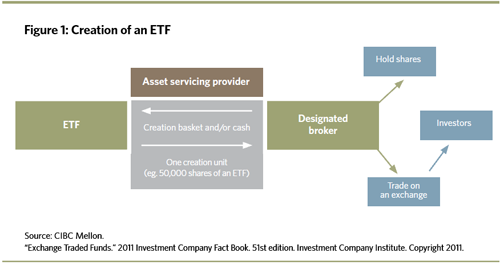Day Trading Exchange Traded Funds (ETFs) For Dummies
Post on: 30 Апрель, 2015 No Comment

Exchange traded funds (or ETFs) are a cross between mutual funds and stocks, and they offer a great way for day traders to get exposure to market segments that may otherwise be difficult to trade. A money management firm buys a group of assets stocks, bonds, or others and then lists shares that trade on the market.
In most cases, the purchased assets are designed to mimic the performance of an index, and investors know what those assets are before they purchase shares in the fund. The big advantage for day traders is that an ETF can be bought or sold at any time during the trading day, long or short, with cash or on margin, through a regular brokerage account. This flexibility is great for day traders.
Although an ETF looks a little bit like an index mutual fund or a market index futures contract, it has a very different structure. ETFs have two types of shares, creation units and retail shares:
Creation units: These are held by authorized participants trading and brokerage firms that agree to commit cash to the fund. Creation unit holders can exchange their shares for the actual securities held in the fund, or they can add the appropriate securities to the fund in order to make new creation units. They do this to keep the value of the ETF in line with the underlying market index.
If the price of an ETF falls below the value of the securities in it, the authorized participants will trade in their creation units for the securities and then sell them on the open market. If the price of an ETF rises above the value of the securities, then the authorized participants will buy up the securities and exchange them for more creation units to sell at a nice profit.
Retail shares: These are the ETF shares that are listed on the exchange to be bought and sold by regular investors and traders. If you day trade ETFs, youll be working with the retail shares.
Most of the time, the price of both the creation units and the retail shares will be right in line with the price of the securities. On occasion, though, the value of the ETF and its investments will diverge.
For example, on May 6, 2010, the U.S. stock market had a major break. Late in the trading day, the Dow Jones Industrial Average fell almost 1,000 points and then recovered almost right away. The cause was a single large sale of futures contracts, but it did a lot of disruption.
Stock prices fell and then rebounded so quickly that ETF pricing couldnt keep up. ETF traders had a difficult time determining when to buy and when to sell because fund valuations were just wrong. It added more uncertainty to an already rough afternoon.
ETFs are available on the big market indexes, as well as a variety of domestic bond indexes, international stock indexes, foreign currencies, and commodities.
Because traders are often interested in a market segment that doesnt have an index on it, some companies develop their own niche indexes and issue ETFs based on them. Hence, you can find ETFs for such markets as green energy and Islamic investing.
ETFs can be bought and sold just like stocks. Customers place orders, usually in round lots, through their brokerage firms. The price quotes come in decimals and include a spread for the dealer.
The firm that sets up the exchange traded fund gets to choose the market where it trades, as long as the fund meets the exchanges requirements for size, liquidity, and financial reporting. Exchange traded funds trade on the NYSE and NASDAQ.
You can learn more about the hundreds of different ETFs on the market on the Morningstar website .
- Add a Comment Print Share














